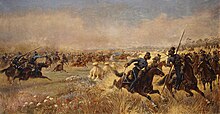Battle_of_Mir_(1812)
Battle of Mir (1812)
1812 battle during the French invasion of Russia
The Battle of Mir took place on 9 and 10 July 1812 during Napoleon's invasion of Russia. Three Polish Lancers divisions battled against Russian cavalry, ending in the first major Russian victory in the war.[8]
| Battle of Mir (1812) | |||||||
|---|---|---|---|---|---|---|---|
| Part of the French invasion of Russia | |||||||
 Cossack cavalry deployed at Mir (by V. Mazurovsky) | |||||||
| |||||||
| Belligerents | |||||||
|
|
| ||||||
| Commanders and leaders | |||||||
|
|
| ||||||
| Strength | |||||||
| Casualties and losses | |||||||
|
308 (1st day)[6] 500–600 (2nd day)[7] 808–908 total losses, including 256 taken prisoner[6] |
25 (1st day)[6] Totally around 180 dead and wounded,[1] including two colonels killed | ||||||
Russian general Matvei Platov had eight Cossack regiments and two Don batteries deployed south of the village of Mir, when one brigade of the Polish Fourth Light Cavalry attacked his advance posts, numbering about 100 men. These advance posts had the dual job of both observation and sentry duty, and to entice the enemy to attack; ambushes of a hundred men each were set up farther down the road to Mir, on either side of it.[9] The Polish general Alexander Rosniecki's forces clashed with Russian Dmitry Vasilchikov's cavalry, resulting in hand-to-hand combat with fairly even losses. Followed by Uhlans, they swept through the village, attacking Platov's main force. A third Polish brigade attempting to join the fight was encircled and broken by Cossacks, after which the entire Polish force gave ground, driven back with the aid of Russian Hussars.[10] After the arrival of Vasilchikov's Akhtyrka Hussars, Dragoons, and other reinforcements, the battle raged for six hours, shifting to the nearby village of Simiakovo. Platov defeated the enemy there, and moved on to Mir, where he inflicted further losses on the enemy before tactically withdrawing.[11] A complete rout was only averted by Tyszkiewicz's brigade, which covered the Polish retreat.[10]
The town of Mir and fort ruins were used as a headquarters by Jérôme Bonaparte, until he decided on the 16th to leave the army, after quarrels with Vandamme, Davout and with his older brother. After retreating, the Mir Castle was destroyed with gunpowder.[12]
- Smith 1998, p. 483.
- Kharkevich, Vladimir (1901). (in Russian) Platov's actions in the rearguard of Bagration in 1812: cavalry battles at Mir and Romanov. pp. 15–16.
- Kharkevich, Vladimir (1901). (in Russian) Platov's actions in the rearguard of Bagration in 1812: cavalry battles at Mir and Romanov. p. 25.
- Kharkevich, Vladimir (1901). (in Russian) Platov's actions in the rearguard of Bagration in 1812: cavalry battles at Mir and Romanov. pp. 25, 18.
- Kharkevich, Vladimir (1901). (in Russian) Platov's actions in the rearguard of Bagration in 1812: cavalry battles at Mir and Romanov. p. 18.
- Kharkevich, Vladimir (1901). (in Russian) Platov's actions in the rearguard of Bagration in 1812: cavalry battles at Mir and Romanov. p. 16.
- Kharkevich, Vladimir (1901). (in Russian) Platov's actions in the rearguard of Bagration in 1812: cavalry battles at Mir and Romanov. pp. 25–26.
- Davies 1998, p. 745.
- Smith, Digby (1998). The Napoleonic Wars Data Book. London. ISBN 1-85367-276-9.
{{cite book}}: CS1 maint: location missing publisher (link) - napoleon-series (2021). "War Against Russia". Retrieved 6 April 2021.
- journal (1896). Journal of the Military Service Institution of the United States, Volume 19.
- Foord, Edward A. (1915). Napoleon's Russian campaign of 1812. Little, Brown and Co.
- cossacks (2021). "Cossacks". Retrieved 6 April 2021.
- Davies, Norman (1998). Europe: a History. HarperCollins. ISBN 9780060974688. Retrieved 6 April 2021.
mir cossacks 1812
 Media related to Battle of Mir (1812) at Wikimedia Commons
Media related to Battle of Mir (1812) at Wikimedia Commons
| Preceded by Battle of Maguilla |
Napoleonic Wars Battle of Mir (1812) |
Succeeded by Battle of Ekau |

